MERCEDES-BENZ E-Class WAGON 2012 W212 Owner's Manual
Manufacturer: MERCEDES-BENZ, Model Year: 2012, Model line: E-Class WAGON, Model: MERCEDES-BENZ E-Class WAGON 2012 W212Pages: 396, PDF Size: 17.07 MB
Page 371 of 396
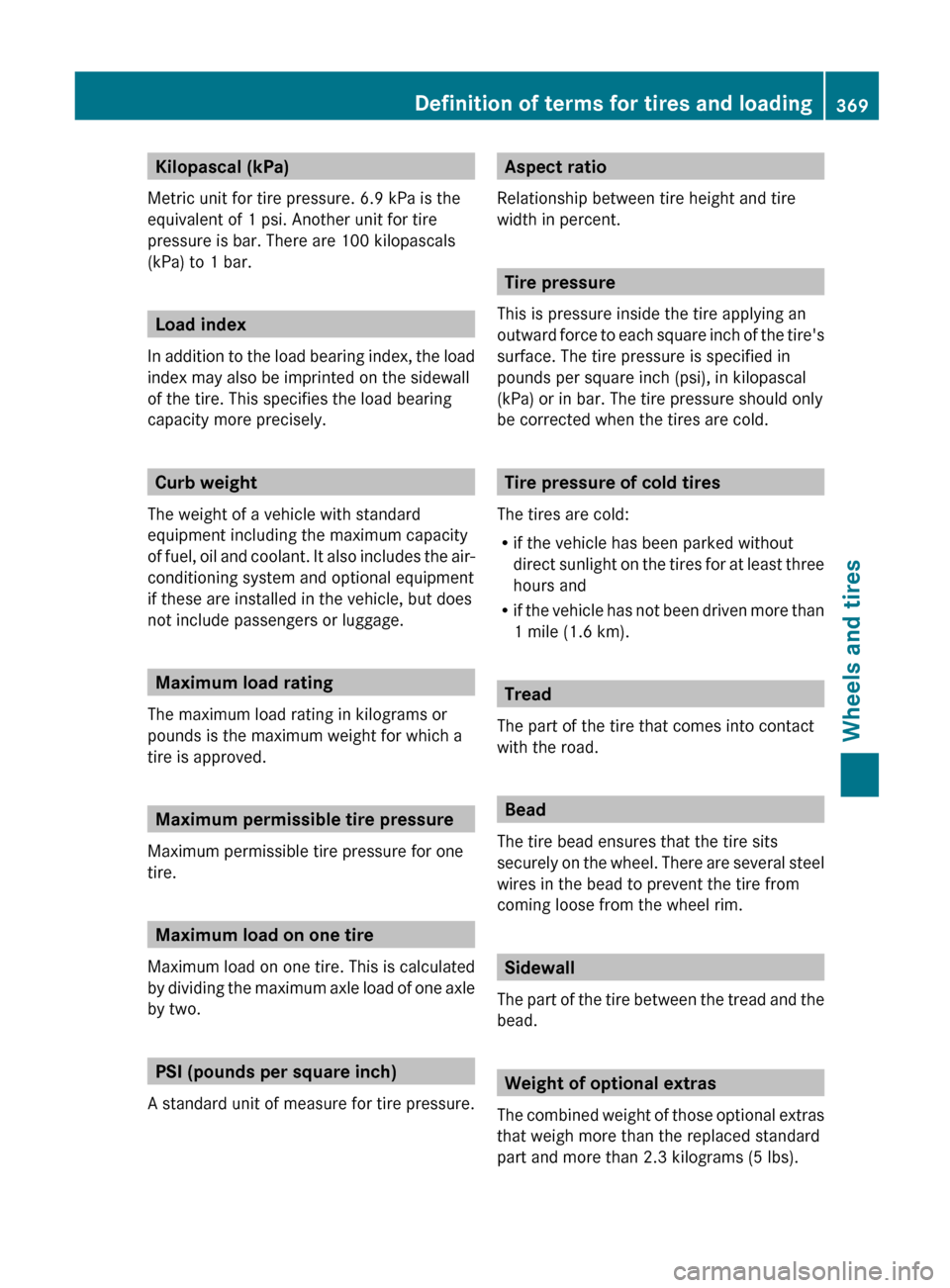
Kilopascal (kPa)
Metric unit for tire pressure. 6.9 kPa is the
equivalent of 1 psi. Another unit for tire
pressure is bar. There are 100 kilopascals
(kPa) to 1 bar.
Load index
In addition to the load bearing index, the load
index may also be imprinted on the sidewall
of the tire. This specifies the load bearing
capacity more precisely.
Curb weight
The weight of a vehicle with standard
equipment including the maximum capacity
of fuel, oil and coolant. It also includes the air-
conditioning system and optional equipment
if these are installed in the vehicle, but does
not include passengers or luggage.
Maximum load rating
The maximum load rating in kilograms or
pounds is the maximum weight for which a
tire is approved.
Maximum permissible tire pressure
Maximum permissible tire pressure for one
tire.
Maximum load on one tire
Maximum load on one tire. This is calculated
by dividing the maximum axle load of one axle
by two.
PSI (pounds per square inch)
A standard unit of measure for tire pressure.
Aspect ratio
Relationship between tire height and tire
width in percent.
Tire pressure
This is pressure inside the tire applying an
outward force to each square inch of the tire's
surface. The tire pressure is specified in
pounds per square inch (psi), in kilopascal
(kPa) or in bar. The tire pressure should only
be corrected when the tires are cold.
Tire pressure of cold tires
The tires are cold:
R if the vehicle has been parked without
direct sunlight on the tires for at least three
hours and
R if the vehicle has not been driven more than
1 mile (1.6 km).
Tread
The part of the tire that comes into contact
with the road.
Bead
The tire bead ensures that the tire sits
securely on the wheel. There are several steel
wires in the bead to prevent the tire from
coming loose from the wheel rim.
Sidewall
The part of the tire between the tread and the
bead.
Weight of optional extras
The combined weight of those optional extras
that weigh more than the replaced standard
part and more than 2.3 kilograms (5 lbs).
Definition of terms for tires and loading369Wheels and tiresZ
Page 372 of 396
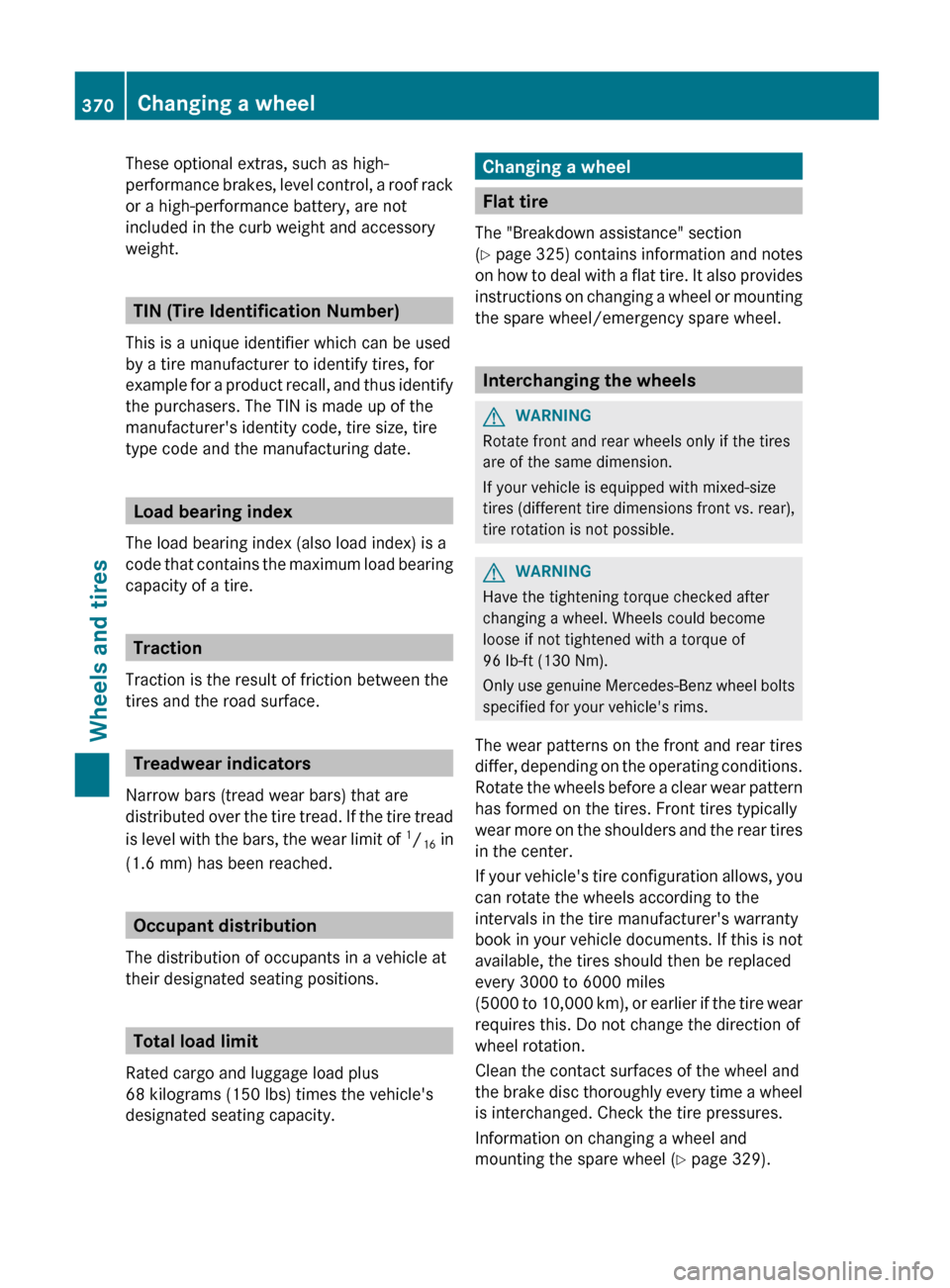
These optional extras, such as high-
performance brakes, level control, a roof rack
or a high-performance battery, are not
included in the curb weight and accessory
weight.
TIN (Tire Identification Number)
This is a unique identifier which can be used
by a tire manufacturer to identify tires, for
example for a product recall, and thus identify
the purchasers. The TIN is made up of the
manufacturer's identity code, tire size, tire
type code and the manufacturing date.
Load bearing index
The load bearing index (also load index) is a
code that contains the maximum load bearing
capacity of a tire.
Traction
Traction is the result of friction between the
tires and the road surface.
Treadwear indicators
Narrow bars (tread wear bars) that are
distributed over the tire tread. If the tire tread
is level with the bars, the wear limit of 1
/ 16 in
(1.6 mm) has been reached.
Occupant distribution
The distribution of occupants in a vehicle at
their designated seating positions.
Total load limit
Rated cargo and luggage load plus
68 kilograms (150 lbs) times the vehicle's
designated seating capacity.
Changing a wheel
Flat tire
The "Breakdown assistance" section
( Y page 325) contains information and notes
on how to deal with a flat tire. It also provides
instructions on changing a wheel or mounting
the spare wheel/emergency spare wheel.
Interchanging the wheels
GWARNING
Rotate front and rear wheels only if the tires
are of the same dimension.
If your vehicle is equipped with mixed-size
tires (different tire dimensions front vs. rear),
tire rotation is not possible.
GWARNING
Have the tightening torque checked after
changing a wheel. Wheels could become
loose if not tightened with a torque of
96 lb-ft (130 Nm).
Only use genuine Mercedes-Benz wheel bolts
specified for your vehicle's rims.
The wear patterns on the front and rear tires
differ, depending on the operating conditions.
Rotate the wheels before a clear wear pattern
has formed on the tires. Front tires typically
wear more on the shoulders and the rear tires
in the center.
If your vehicle's tire configuration allows, you
can rotate the wheels according to the
intervals in the tire manufacturer's warranty
book in your vehicle documents. If this is not
available, the tires should then be replaced
every 3000 to 6000 miles
( 5000 to 10,000 km), or earlier if the tire wear
requires this. Do not change the direction of
wheel rotation.
Clean the contact surfaces of the wheel and
the brake disc thoroughly every time a wheel
is interchanged. Check the tire pressures.
Information on changing a wheel and
mounting the spare wheel ( Y page 329).
370Changing a wheelWheels and tires
Page 373 of 396
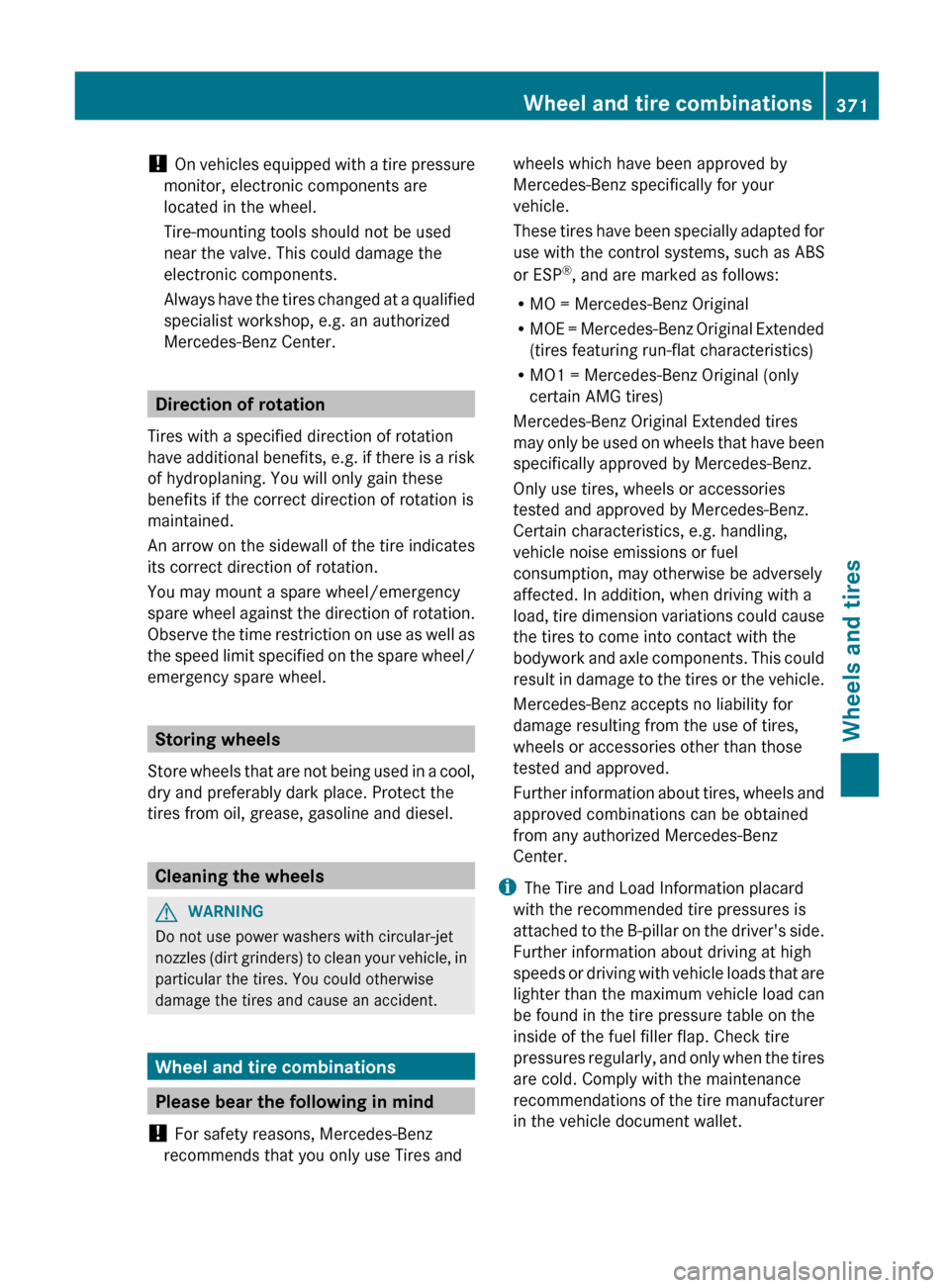
! On vehicles equipped with a tire pressure
monitor, electronic components are
located in the wheel.
Tire-mounting tools should not be used
near the valve. This could damage the
electronic components.
Always have the tires changed at a qualified
specialist workshop, e.g. an authorized
Mercedes-Benz Center.
Direction of rotation
Tires with a specified direction of rotation
have additional benefits, e.g. if there is a risk
of hydroplaning. You will only gain these
benefits if the correct direction of rotation is
maintained.
An arrow on the sidewall of the tire indicates
its correct direction of rotation.
You may mount a spare wheel/emergency
spare wheel against the direction of rotation.
Observe the time restriction on use as well as
the speed limit specified on the spare wheel/
emergency spare wheel.
Storing wheels
Store wheels that are not being used in a cool,
dry and preferably dark place. Protect the
tires from oil, grease, gasoline and diesel.
Cleaning the wheels
GWARNING
Do not use power washers with circular-jet
nozzles (dirt grinders) to clean your vehicle, in
particular the tires. You could otherwise
damage the tires and cause an accident.
Wheel and tire combinations
Please bear the following in mind
! For safety reasons, Mercedes-Benz
recommends that you only use Tires and
wheels which have been approved by
Mercedes-Benz specifically for your
vehicle.
These tires have been specially adapted for
use with the control systems, such as ABS
or ESP ®
, and are marked as follows:
R MO = Mercedes-Benz Original
R MOE = Mercedes-Benz Original Extended
(tires featuring run-flat characteristics)
R MO1 = Mercedes-Benz Original (only
certain AMG tires)
Mercedes-Benz Original Extended tires
may only be used on wheels that have been
specifically approved by Mercedes-Benz.
Only use tires, wheels or accessories
tested and approved by Mercedes-Benz.
Certain characteristics, e.g. handling,
vehicle noise emissions or fuel
consumption, may otherwise be adversely
affected. In addition, when driving with a
load, tire dimension variations could cause
the tires to come into contact with the
bodywork and axle components. This could
result in damage to the tires or the vehicle.
Mercedes-Benz accepts no liability for
damage resulting from the use of tires,
wheels or accessories other than those
tested and approved.
Further information about tires, wheels and
approved combinations can be obtained
from any authorized Mercedes-Benz
Center.
i The Tire and Load Information placard
with the recommended tire pressures is
attached to the B-pillar on the driver's side.
Further information about driving at high
speeds or driving with vehicle loads that are
lighter than the maximum vehicle load can
be found in the tire pressure table on the
inside of the fuel filler flap. Check tire
pressures regularly, and only when the tires
are cold. Comply with the maintenance
recommendations of the tire manufacturer
in the vehicle document wallet.Wheel and tire combinations371Wheels and tiresZ
Page 374 of 396
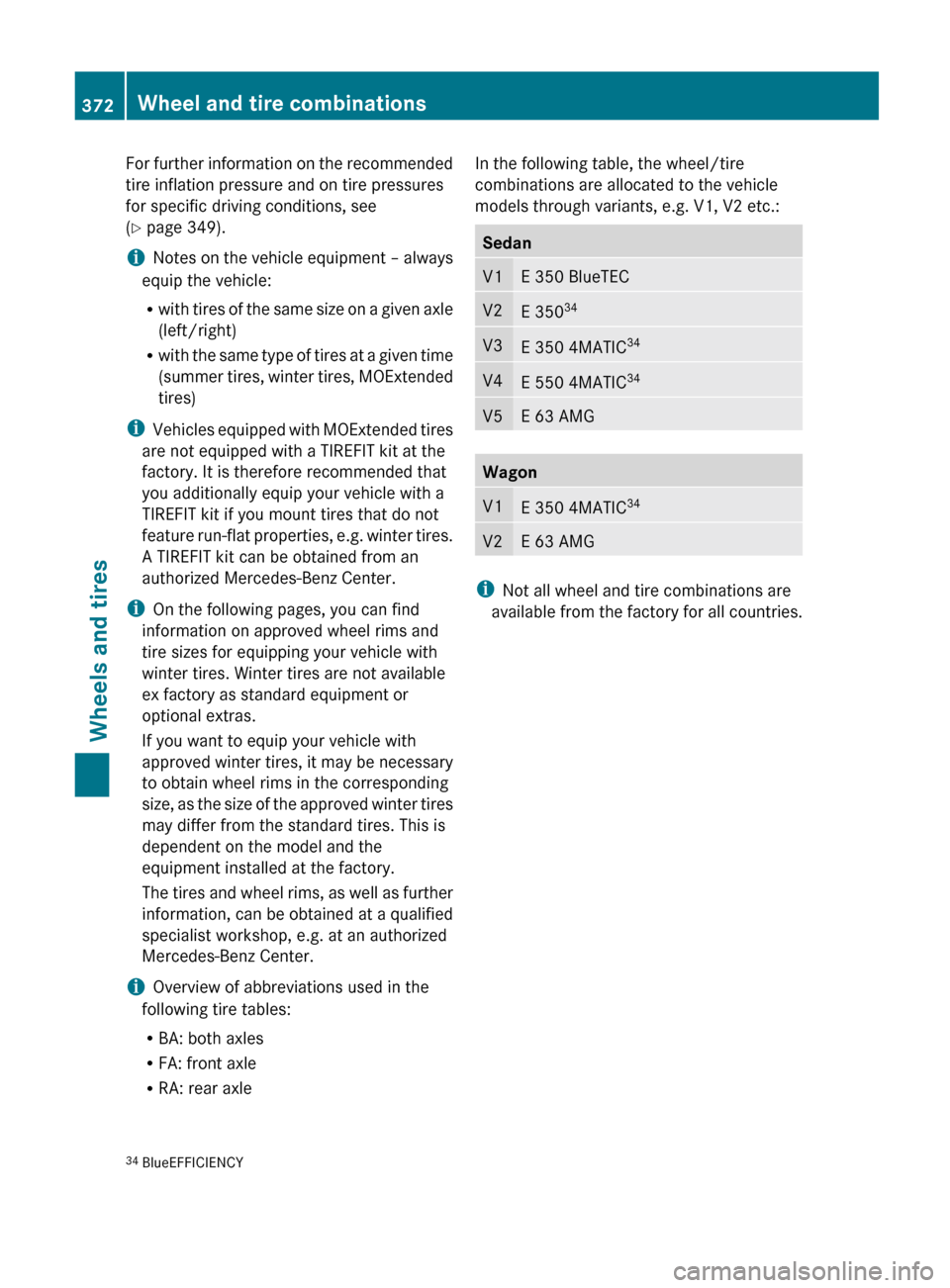
For further information on the recommended
tire inflation pressure and on tire pressures
for specific driving conditions, see
( Y page 349).
i Notes on the vehicle equipment – always
equip the vehicle:
R with tires of the same size on a given axle
(left/right)
R with the same type of tires at a given time
(summer tires, winter tires, MOExtended
tires)
i Vehicles equipped with MOExtended tires
are not equipped with a TIREFIT kit at the
factory. It is therefore recommended that
you additionally equip your vehicle with a
TIREFIT kit if you mount tires that do not
feature run-flat properties, e.g. winter tires.
A TIREFIT kit can be obtained from an
authorized Mercedes-Benz Center.
i On the following pages, you can find
information on approved wheel rims and
tire sizes for equipping your vehicle with
winter tires. Winter tires are not available
ex factory as standard equipment or
optional extras.
If you want to equip your vehicle with
approved winter tires, it may be necessary
to obtain wheel rims in the corresponding
size, as the size of the approved winter tires
may differ from the standard tires. This is
dependent on the model and the
equipment installed at the factory.
The tires and wheel rims, as well as further
information, can be obtained at a qualified
specialist workshop, e.g. at an authorized
Mercedes-Benz Center.
i Overview of abbreviations used in the
following tire tables:
R BA: both axles
R FA: front axle
R RA: rear axleIn the following table, the wheel/tire
combinations are allocated to the vehicle
models through variants, e.g. V1, V2 etc.:SedanV1E 350 BlueTECV2E 350 34V3E 350 4MATIC 34V4E 550 4MATIC34V5E 63 AMGWagonV1E 350 4MATIC34V2E 63 AMG
i
Not all wheel and tire combinations are
available from the factory for all countries.
34 BlueEFFICIENCY372Wheel and tire combinationsWheels and tires
Page 375 of 396
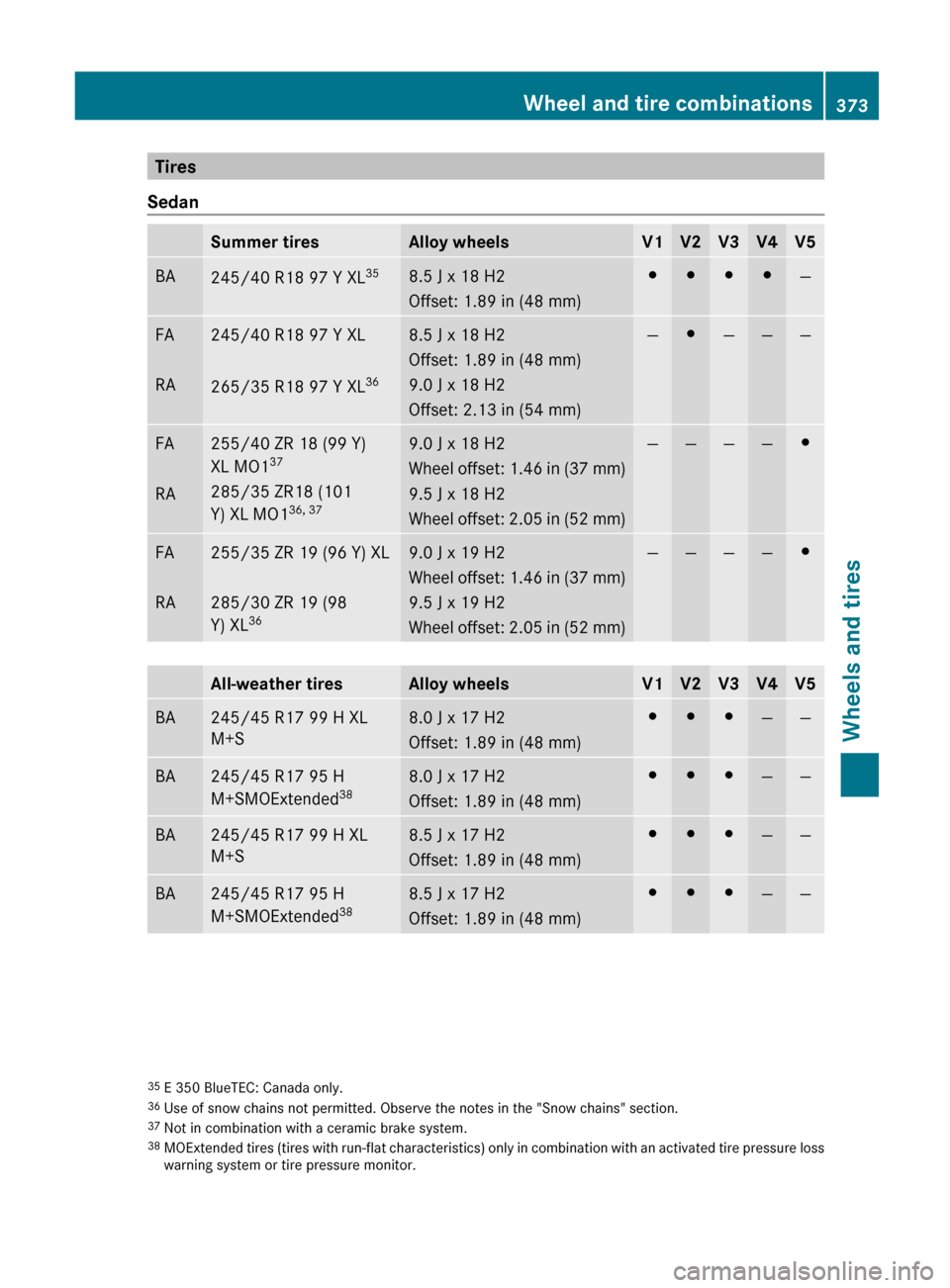
Tires
SedanSummer tiresAlloy wheelsV1V2V3V4V5BA245/40 R18 97 Y XL 358.5 J x 18 H2
Offset: 1.89 in (48 mm)####—FA
RA245/40 R18 97 Y XL
265/35 R18 97 Y XL 368.5 J x 18 H2
Offset: 1.89 in (48 mm)
9.0 J x 18 H2
Offset: 2.13 in (54 mm)—#———FA
RA255/40 ZR 18 (99 Y)
XL MO1 37
285/35 ZR18 (101
Y) XL MO1 36, 379.0 J x 18 H2
Wheel offset: 1.46 in (37 mm)
9.5 J x 18 H2
Wheel offset: 2.05 in (52 mm)————#FA
RA255/35 ZR 19 (96 Y) XL
285/30 ZR 19 (98
Y) XL 369.0 J x 19 H2
Wheel offset: 1.46 in (37 mm)
9.5 J x 19 H2
Wheel offset: 2.05 in (52 mm)————#All-weather tiresAlloy wheelsV1V2V3V4V5BA245/45 R17 99 H XL
M+S8.0 J x 17 H2
Offset: 1.89 in (48 mm)###——BA245/45 R17 95 H
M+SMOExtended 388.0 J x 17 H2
Offset: 1.89 in (48 mm)###——BA245/45 R17 99 H XL
M+S8.5 J x 17 H2
Offset: 1.89 in (48 mm)###——BA245/45 R17 95 H
M+SMOExtended 388.5 J x 17 H2
Offset: 1.89 in (48 mm)###——35 E 350 BlueTEC: Canada only.
36 Use of snow chains not permitted. Observe the notes in the "Snow chains" section.
37 Not in combination with a ceramic brake system.
38 MOExtended tires (tires with run-flat characteristics) only in combination with an activated tire pressure loss
warning system or tire pressure monitor.Wheel and tire combinations373Wheels and tiresZ
Page 376 of 396
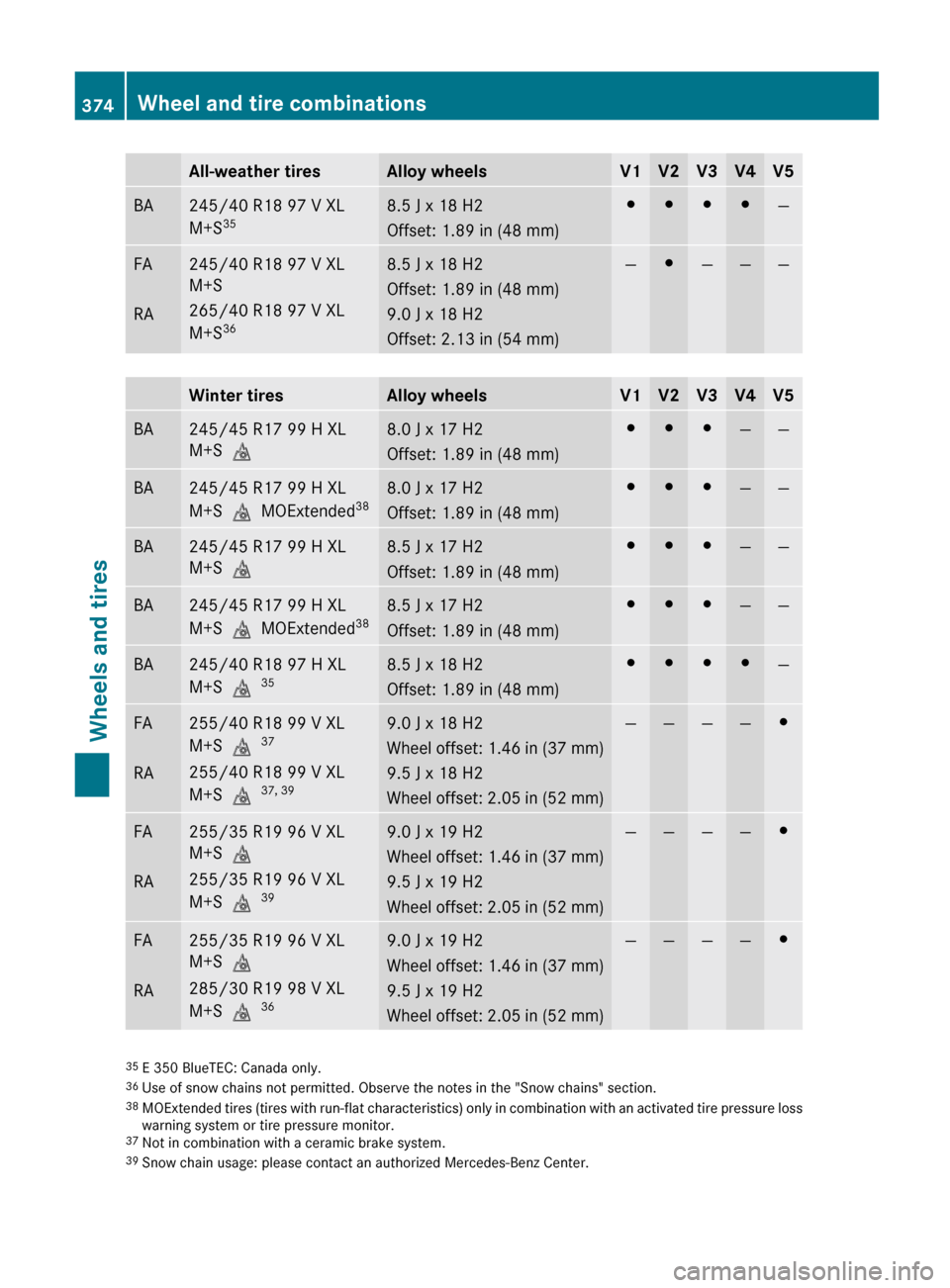
All-weather tiresAlloy wheelsV1V2V3V4V5BA245/40 R18 97 V XL
M+S 358.5 J x 18 H2
Offset: 1.89 in (48 mm)####—FA
RA245/40 R18 97 V XL
M+S
265/40 R18 97 V XL
M+S 368.5 J x 18 H2
Offset: 1.89 in (48 mm)
9.0 J x 18 H2
Offset: 2.13 in (54 mm)—#———Winter tiresAlloy wheelsV1V2V3V4V5BA245/45 R17 99 H XL
M+S i8.0 J x 17 H2
Offset: 1.89 in (48 mm)###——BA245/45 R17 99 H XL
M+S i MOExtended 388.0 J x 17 H2
Offset: 1.89 in (48 mm)###——BA245/45 R17 99 H XL
M+S i8.5 J x 17 H2
Offset: 1.89 in (48 mm)###——BA245/45 R17 99 H XL
M+S i MOExtended 388.5 J x 17 H2
Offset: 1.89 in (48 mm)###——BA245/40 R18 97 H XL
M+S i 358.5 J x 18 H2
Offset: 1.89 in (48 mm)####—FA
RA255/40 R18 99 V XL
M+S i 37
255/40 R18 99 V XL
M+S i 37, 399.0 J x 18 H2
Wheel offset: 1.46 in (37 mm)
9.5 J x 18 H2
Wheel offset: 2.05 in (52 mm)————#FA
RA255/35 R19 96 V XL
M+S i
255/35 R19 96 V XL
M+S i 399.0 J x 19 H2
Wheel offset: 1.46 in (37 mm)
9.5 J x 19 H2
Wheel offset: 2.05 in (52 mm)————#FA
RA255/35 R19 96 V XL
M+S i
285/30 R19 98 V XL
M+S i 369.0 J x 19 H2
Wheel offset: 1.46 in (37 mm)
9.5 J x 19 H2
Wheel offset: 2.05 in (52 mm)————#35 E 350 BlueTEC: Canada only.
36 Use of snow chains not permitted. Observe the notes in the "Snow chains" section.
38 MOExtended tires (tires with run-flat characteristics) only in combination with an activated tire pressure loss
warning system or tire pressure monitor.
37 Not in combination with a ceramic brake system.
39 Snow chain usage: please contact an authorized Mercedes-Benz Center.374Wheel and tire combinationsWheels and tires
Page 377 of 396
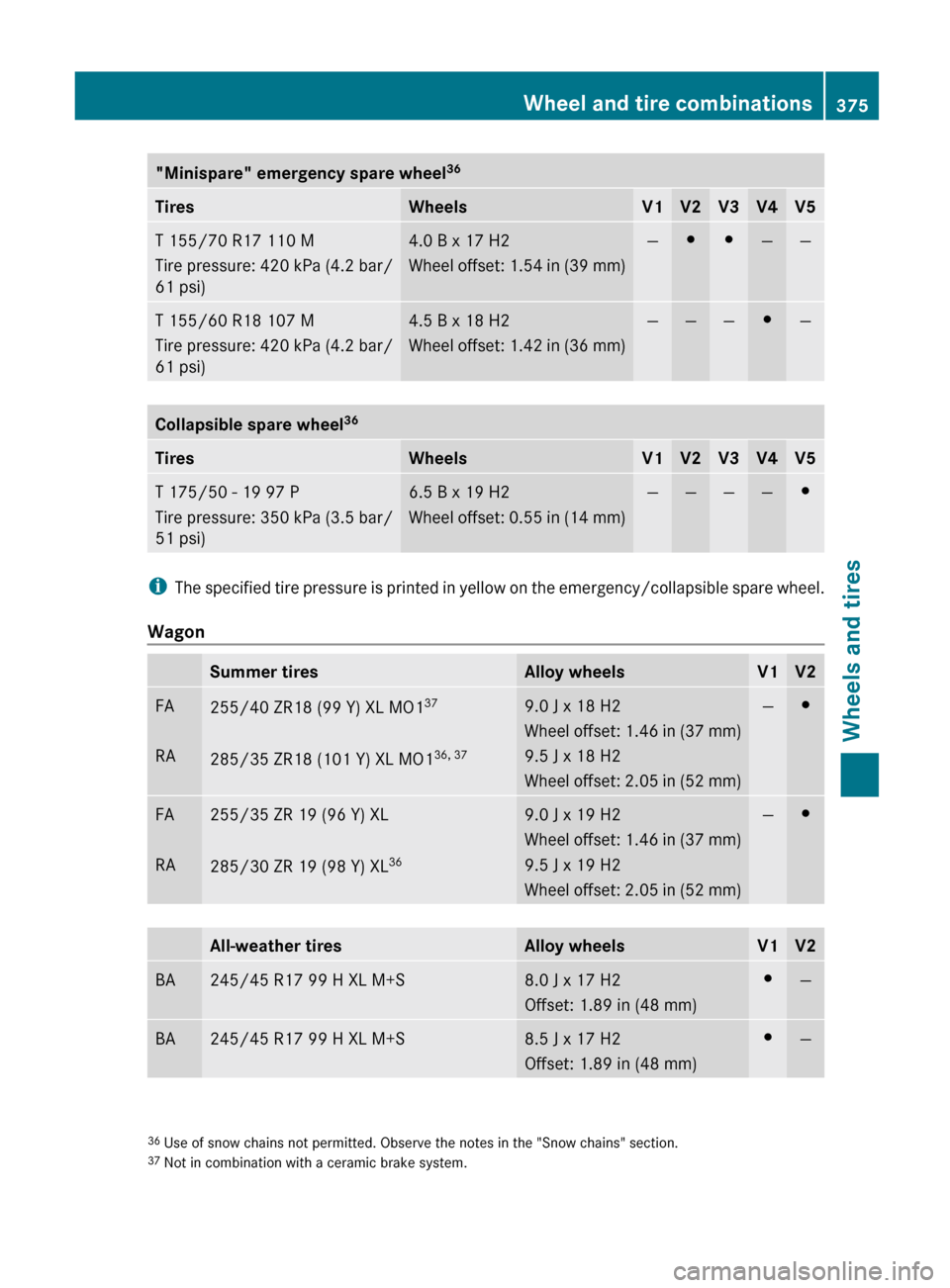
"Minispare" emergency spare wheel36TiresWheelsV1V2V3V4V5T 155/70 R17 110 M
Tire pressure: 420 kPa (4.2 bar/
61 psi)4.0 B x 17 H2
Wheel offset: 1.54 in (39 mm)—##——T 155/60 R18 107 M
Tire pressure: 420 kPa (4.2 bar/
61 psi)4.5 B x 18 H2
Wheel offset: 1.42 in (36 mm)———#—Collapsible spare wheel 36TiresWheelsV1V2V3V4V5T 175/50 - 19 97 P
Tire pressure: 350 kPa (3.5 bar/
51 psi)6.5 B x 19 H2
Wheel offset: 0.55 in (14 mm)————#
i The specified tire pressure is printed in yellow on the emergency/collapsible spare wheel.
Wagon
Summer tiresAlloy wheelsV1V2FA
RA255/40 ZR18 (99 Y) XL MO1 37
285/35 ZR18 (101 Y) XL MO1 36, 379.0 J x 18 H2
Wheel offset: 1.46 in (37 mm)
9.5 J x 18 H2
Wheel offset: 2.05 in (52 mm)—#FA
RA255/35 ZR 19 (96 Y) XL
285/30 ZR 19 (98 Y) XL 369.0 J x 19 H2
Wheel offset: 1.46 in (37 mm)
9.5 J x 19 H2
Wheel offset: 2.05 in (52 mm)—#All-weather tiresAlloy wheelsV1V2BA245/45 R17 99 H XL M+S8.0 J x 17 H2
Offset: 1.89 in (48 mm)#—BA245/45 R17 99 H XL M+S8.5 J x 17 H2
Offset: 1.89 in (48 mm)#—36 Use of snow chains not permitted. Observe the notes in the "Snow chains" section.
37 Not in combination with a ceramic brake system.Wheel and tire combinations375Wheels and tiresZ
Page 378 of 396
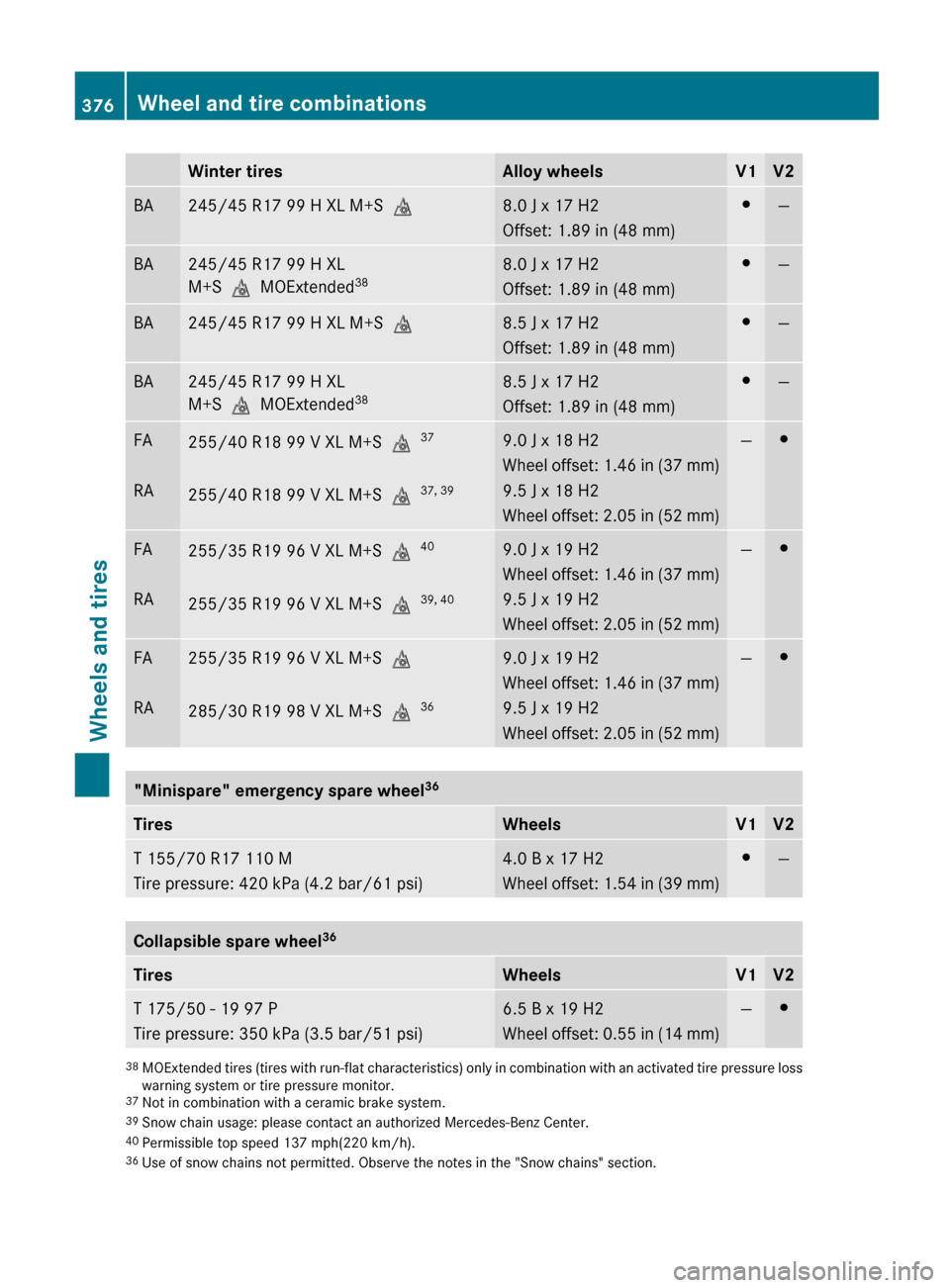
Winter tiresAlloy wheelsV1V2BA245/45 R17 99 H XL M+Si8.0 J x 17 H2
Offset: 1.89 in (48 mm)#—BA245/45 R17 99 H XL
M+S i MOExtended 388.0 J x 17 H2
Offset: 1.89 in (48 mm)#—BA245/45 R17 99 H XL M+S i8.5 J x 17 H2
Offset: 1.89 in (48 mm)#—BA245/45 R17 99 H XL
M+S i MOExtended 388.5 J x 17 H2
Offset: 1.89 in (48 mm)#—FA
RA255/40 R18 99 V XL M+S i37
255/40 R18 99 V XL M+S i37, 399.0 J x 18 H2
Wheel offset: 1.46 in (37 mm)
9.5 J x 18 H2
Wheel offset: 2.05 in (52 mm)—#FA
RA255/35 R19 96 V XL M+S i40
255/35 R19 96 V XL M+S i39, 409.0 J x 19 H2
Wheel offset: 1.46 in (37 mm)
9.5 J x 19 H2
Wheel offset: 2.05 in (52 mm)—#FA
RA255/35 R19 96 V XL M+S i
285/30 R19 98 V XL M+S i369.0 J x 19 H2
Wheel offset: 1.46 in (37 mm)
9.5 J x 19 H2
Wheel offset: 2.05 in (52 mm)—#"Minispare" emergency spare wheel 36TiresWheelsV1V2T 155/70 R17 110 M
Tire pressure: 420 kPa (4.2 bar/61 psi)4.0 B x 17 H2
Wheel offset: 1.54 in (39 mm)#—Collapsible spare wheel 36TiresWheelsV1V2T 175/50 - 19 97 P
Tire pressure: 350 kPa (3.5 bar/51 psi)6.5 B x 19 H2
Wheel offset: 0.55 in (14 mm)—#38 MOExtended tires (tires with run-flat characteristics) only in combination with an activated tire pressure loss
warning system or tire pressure monitor.
37 Not in combination with a ceramic brake system.
39 Snow chain usage: please contact an authorized Mercedes-Benz Center.
40 Permissible top speed 137 mph(220 km/h).
36 Use of snow chains not permitted. Observe the notes in the "Snow chains" section.376Wheel and tire combinationsWheels and tires
Page 379 of 396
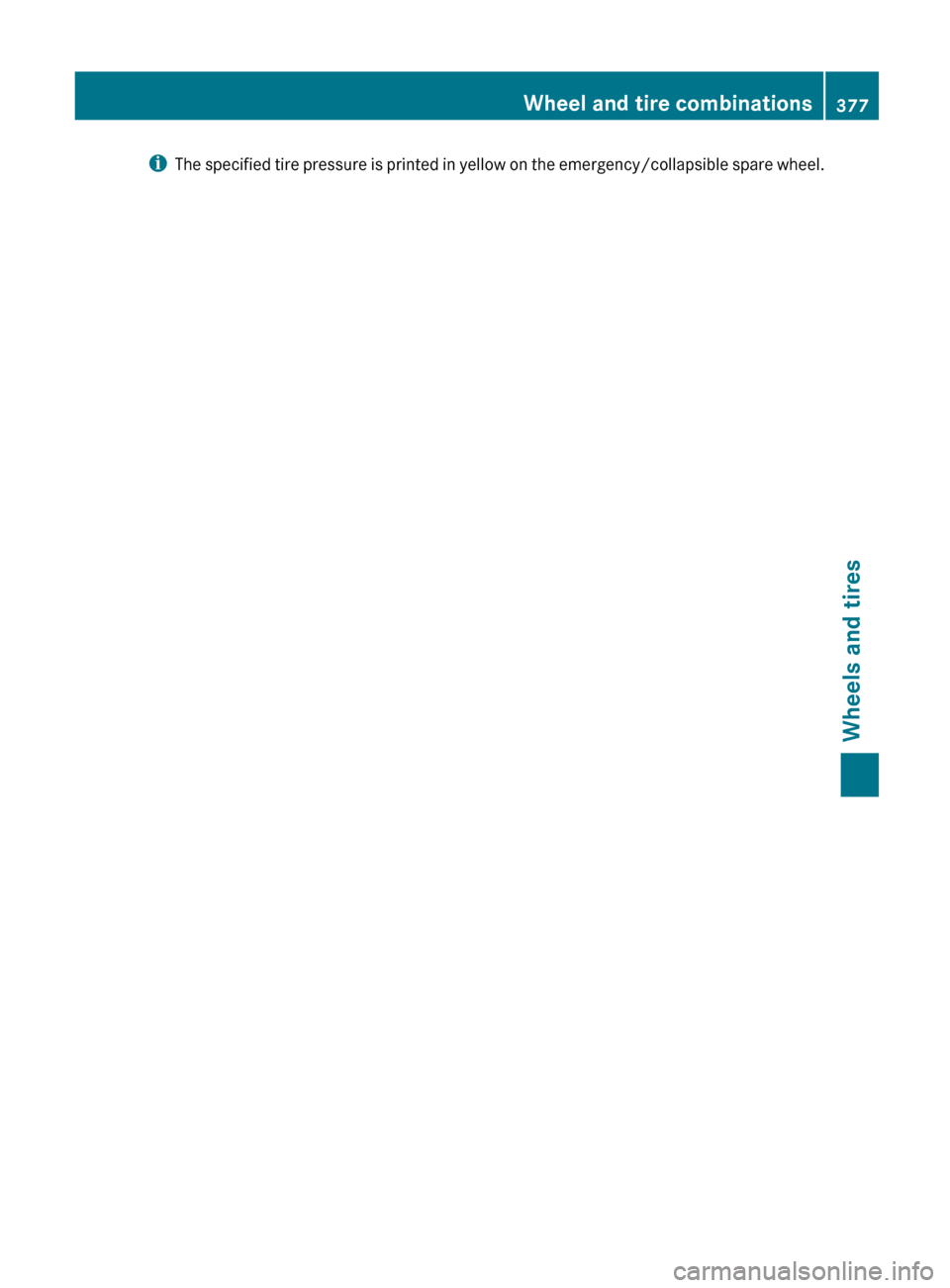
iThe specified tire pressure is printed in yellow on the emergency/collapsible spare wheel.Wheel and tire combinations377Wheels and tiresZ
Page 380 of 396

378